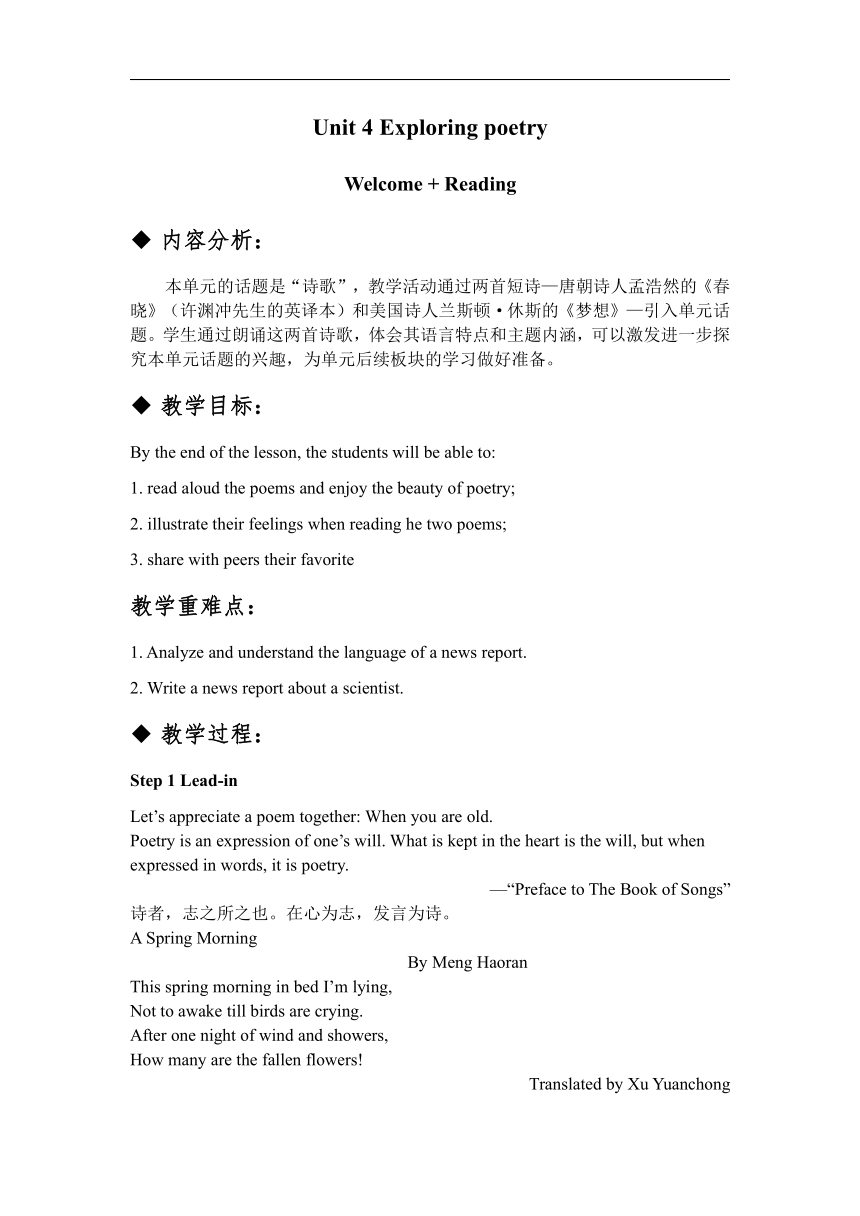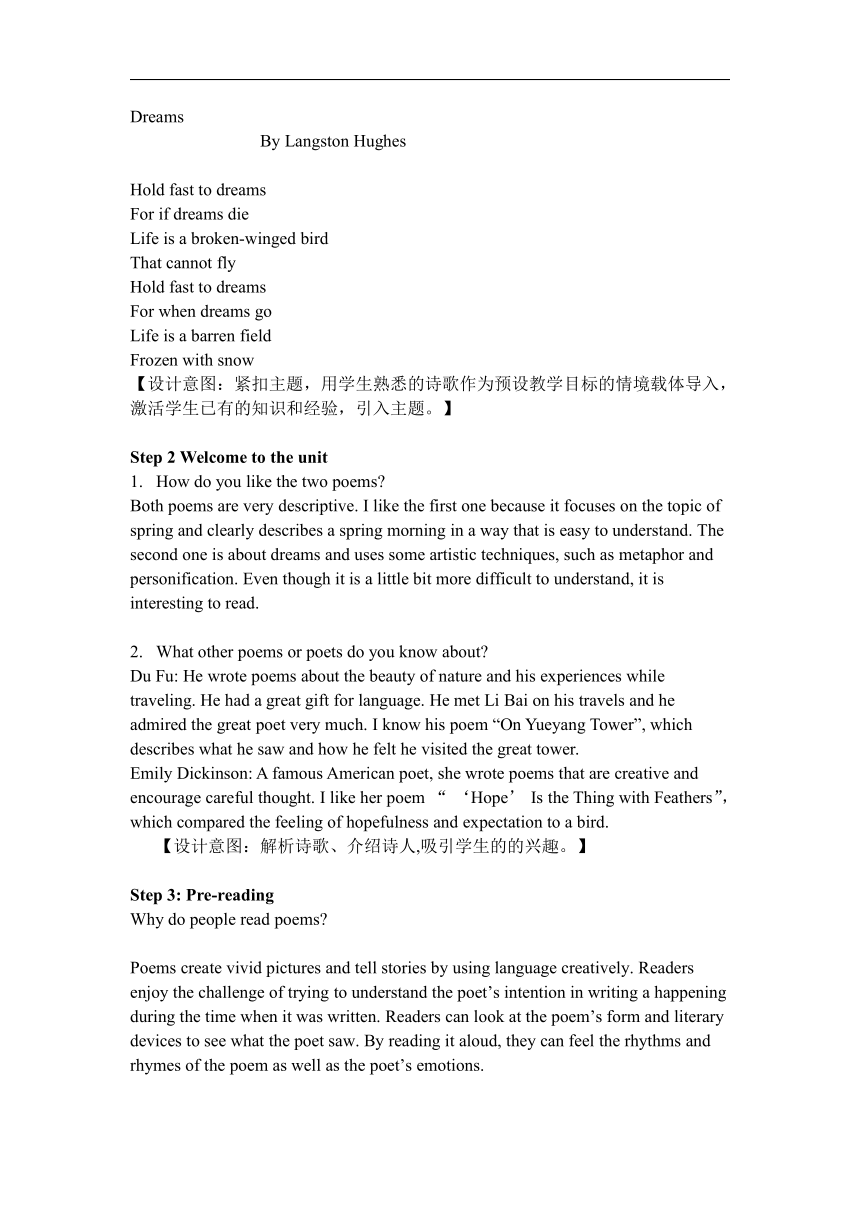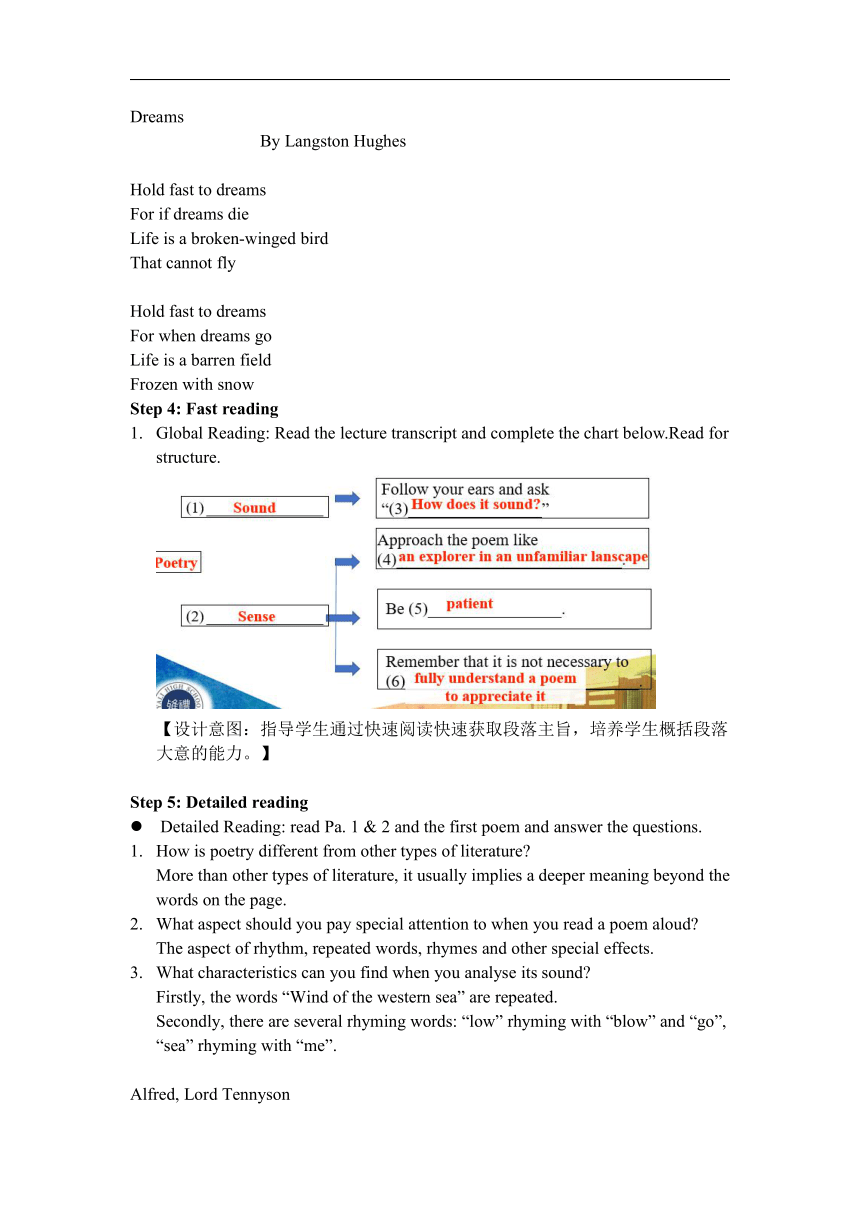牛津译林版(2019)选择性必修 第一册Unit 4 Exploring Poetry Welcome to the unit & Reading 教案
文档属性
| 名称 | 牛津译林版(2019)选择性必修 第一册Unit 4 Exploring Poetry Welcome to the unit & Reading 教案 |  | |
| 格式 | docx | ||
| 文件大小 | 143.6KB | ||
| 资源类型 | 教案 | ||
| 版本资源 | 牛津译林版(2019) | ||
| 科目 | 英语 | ||
| 更新时间 | 2024-03-04 09:31:35 | ||
图片预览



文档简介
Unit 4 Exploring poetry
Welcome + Reading
内容分析:
本单元的话题是“诗歌”,教学活动通过两首短诗—唐朝诗人孟浩然的《春晓》(许渊冲先生的英译本)和美国诗人兰斯顿·休斯的《梦想》—引入单元话题。学生通过朗诵这两首诗歌,体会其语言特点和主题内涵,可以激发进一步探究本单元话题的兴趣,为单元后续板块的学习做好准备。
教学目标:
By the end of the lesson, the students will be able to:
1. read aloud the poems and enjoy the beauty of poetry;
2. illustrate their feelings when reading he two poems;
3. share with peers their favorite
教学重难点:
1. Analyze and understand the language of a news report.
2. Write a news report about a scientist.
教学过程:
Step 1 Lead-in
Let’s appreciate a poem together: When you are old.
Poetry is an expression of one’s will. What is kept in the heart is the will, but when expressed in words, it is poetry.
—“Preface to The Book of Songs”
诗者,志之所之也。在心为志,发言为诗。
A Spring Morning
By Meng Haoran
This spring morning in bed I’m lying,
Not to awake till birds are crying.
After one night of wind and showers,
How many are the fallen flowers!
Translated by Xu Yuanchong
Dreams
By Langston Hughes
Hold fast to dreams
For if dreams die
Life is a broken-winged bird
That cannot fly
Hold fast to dreams
For when dreams go
Life is a barren field
Frozen with snow
【设计意图:紧扣主题,用学生熟悉的诗歌作为预设教学目标的情境载体导入,激活学生已有的知识和经验,引入主题。】
Step 2 Welcome to the unit
How do you like the two poems
Both poems are very descriptive. I like the first one because it focuses on the topic of spring and clearly describes a spring morning in a way that is easy to understand. The second one is about dreams and uses some artistic techniques, such as metaphor and personification. Even though it is a little bit more difficult to understand, it is interesting to read.
What other poems or poets do you know about
Du Fu: He wrote poems about the beauty of nature and his experiences while traveling. He had a great gift for language. He met Li Bai on his travels and he admired the great poet very much. I know his poem “On Yueyang Tower”, which describes what he saw and how he felt he visited the great tower.
Emily Dickinson: A famous American poet, she wrote poems that are creative and encourage careful thought. I like her poem “ ‘Hope’ Is the Thing with Feathers”, which compared the feeling of hopefulness and expectation to a bird.
【设计意图:解析诗歌、介绍诗人,吸引学生的的兴趣。】
Step 3: Pre-reading
Why do people read poems
Poems create vivid pictures and tell stories by using language creatively. Readers enjoy the challenge of trying to understand the poet’s intention in writing a happening during the time when it was written. Readers can look at the poem’s form and literary devices to see what the poet saw. By reading it aloud, they can feel the rhythms and rhymes of the poem as well as the poet’s emotions.
Dreams
By Langston Hughes
Hold fast to dreams
For if dreams die
Life is a broken-winged bird
That cannot fly
Hold fast to dreams
For when dreams go
Life is a barren field
Frozen with snow
Step 4: Fast reading
Global Reading: Read the lecture transcript and complete the chart below.Read for structure.
【设计意图:指导学生通过快速阅读快速获取段落主旨,培养学生概括段落大意的能力。】
Step 5: Detailed reading
Detailed Reading: read Pa. 1 & 2 and the first poem and answer the questions.
How is poetry different from other types of literature
More than other types of literature, it usually implies a deeper meaning beyond the words on the page.
What aspect should you pay special attention to when you read a poem aloud
The aspect of rhythm, repeated words, rhymes and other special effects.
What characteristics can you find when you analyse its sound
Firstly, the words “Wind of the western sea” are repeated.
Secondly, there are several rhyming words: “low” rhyming with “blow” and “go”, “sea” rhyming with “me”.
Alfred, Lord Tennyson
(1809–1892)
More than any other Victorian-era writer, Tennyson has seemed the representative of his age. In his own day he was said to be — with Queen Victoria and Prime Minister William Gladstone — one of the three most famous living persons, a reputation no other poet writing in English has ever had.
Sweet and low, sweet and low,
Wind of the western sea,
Low, low, breathe and blow,
Wind of the western sea.
Over the rolling waters go;
Come from the dying moon, and blow,
Blow him again to me,
While my little one, while my pretty one sleeps.
(From “Sweet and Low”
by Alfred Tennyson)
Q:What images come into your mind when you are reading it
A:When I read it, I can see in my mind the image of a bird in a cage, which is desperately singing for freedom.
Detailed Reading: read Para. 3 and the second poem and finish the chart.
An acclaimed American poet, storyteller, activist, and autobiographer, Angelou worked for Dr. Martin Luther King Jr. and was also an educator who served as a professor in the university.
The caged bird sings
with a fearful trill
of things unknown
but longed for still
and his tune is heard
on the distant hill
for the caged bird
sings of freedom.
(From “Caged Bird”
by Maya Angelou)
Detailed Reading: read Pa. 4-6 and the third poem and answer the questions.
What does the lecturer think of poems that are easy to understand
They are often less interesting than those that constantly reveal deeper and previously unrecognized meanings.
What should you do when you have difficulty in understanding a poem
We should set it aside and come back to it later. With our insight into life becoming deeper, we may one day find it not so hard to understand at all.
According to the lecturer, what is more important in appreciating a poem
Poetry reading can make us feel something or let us perceive another level of meaning, which is more important and worth our effort.
What is the function of the poem quoted after Para. 4
This poem is not easy to understand and is suitable as an example to support the tip of “be patient when having trouble in understanding a poem”.
Robert Frost (1874-1963) was an American poet who was much admired for his description of the rural life of New England, and his realistic verse portraying ordinary people in everyday situations. His famous poems include: Stopping by Woods on a Snowy Evening and The Road Not Taken.
【设计意图:帮助学生梳理文章的关键信息要素。接下来通过完成一些问题,引导学生学会自主阅读、归纳信息、提炼要点。】
Step 6: Post reading
Please choose one of the poems in the lecture transcript and think about the sound and sense of the poem.
The poem by Maya Angelou describes the image of a caged bird wanting to be free. The lines are short and simple, which makes the message more direct and powerful. The short lines could also imply the sense of being in a small cage with very little space to fly around in. This does not stop the bird from singing though, and by repeating the sound of some words: “trill”, “still”, and “hill” I can imagine the sound that the bird makes it sings its lonely song. “Caged Bird” reminds me of the possibilities we have in life and that we should look past our current limitations.
Please give some other tips on how to read a poem.
From my point of understand a poem better, we should also know more about the poet and the background in which the poem was created — the theme of a poem usually has a close relationship with the background in which the poet wrote it.
【设计意图:引导学生从赏析的角度解读文本。】
Step 7: Homework
Finish B1 on P47.
Choose a poem that impresses you most. Discuss it with your partners and share the reasons why it impressed you.
教学反思
Welcome + Reading
内容分析:
本单元的话题是“诗歌”,教学活动通过两首短诗—唐朝诗人孟浩然的《春晓》(许渊冲先生的英译本)和美国诗人兰斯顿·休斯的《梦想》—引入单元话题。学生通过朗诵这两首诗歌,体会其语言特点和主题内涵,可以激发进一步探究本单元话题的兴趣,为单元后续板块的学习做好准备。
教学目标:
By the end of the lesson, the students will be able to:
1. read aloud the poems and enjoy the beauty of poetry;
2. illustrate their feelings when reading he two poems;
3. share with peers their favorite
教学重难点:
1. Analyze and understand the language of a news report.
2. Write a news report about a scientist.
教学过程:
Step 1 Lead-in
Let’s appreciate a poem together: When you are old.
Poetry is an expression of one’s will. What is kept in the heart is the will, but when expressed in words, it is poetry.
—“Preface to The Book of Songs”
诗者,志之所之也。在心为志,发言为诗。
A Spring Morning
By Meng Haoran
This spring morning in bed I’m lying,
Not to awake till birds are crying.
After one night of wind and showers,
How many are the fallen flowers!
Translated by Xu Yuanchong
Dreams
By Langston Hughes
Hold fast to dreams
For if dreams die
Life is a broken-winged bird
That cannot fly
Hold fast to dreams
For when dreams go
Life is a barren field
Frozen with snow
【设计意图:紧扣主题,用学生熟悉的诗歌作为预设教学目标的情境载体导入,激活学生已有的知识和经验,引入主题。】
Step 2 Welcome to the unit
How do you like the two poems
Both poems are very descriptive. I like the first one because it focuses on the topic of spring and clearly describes a spring morning in a way that is easy to understand. The second one is about dreams and uses some artistic techniques, such as metaphor and personification. Even though it is a little bit more difficult to understand, it is interesting to read.
What other poems or poets do you know about
Du Fu: He wrote poems about the beauty of nature and his experiences while traveling. He had a great gift for language. He met Li Bai on his travels and he admired the great poet very much. I know his poem “On Yueyang Tower”, which describes what he saw and how he felt he visited the great tower.
Emily Dickinson: A famous American poet, she wrote poems that are creative and encourage careful thought. I like her poem “ ‘Hope’ Is the Thing with Feathers”, which compared the feeling of hopefulness and expectation to a bird.
【设计意图:解析诗歌、介绍诗人,吸引学生的的兴趣。】
Step 3: Pre-reading
Why do people read poems
Poems create vivid pictures and tell stories by using language creatively. Readers enjoy the challenge of trying to understand the poet’s intention in writing a happening during the time when it was written. Readers can look at the poem’s form and literary devices to see what the poet saw. By reading it aloud, they can feel the rhythms and rhymes of the poem as well as the poet’s emotions.
Dreams
By Langston Hughes
Hold fast to dreams
For if dreams die
Life is a broken-winged bird
That cannot fly
Hold fast to dreams
For when dreams go
Life is a barren field
Frozen with snow
Step 4: Fast reading
Global Reading: Read the lecture transcript and complete the chart below.Read for structure.
【设计意图:指导学生通过快速阅读快速获取段落主旨,培养学生概括段落大意的能力。】
Step 5: Detailed reading
Detailed Reading: read Pa. 1 & 2 and the first poem and answer the questions.
How is poetry different from other types of literature
More than other types of literature, it usually implies a deeper meaning beyond the words on the page.
What aspect should you pay special attention to when you read a poem aloud
The aspect of rhythm, repeated words, rhymes and other special effects.
What characteristics can you find when you analyse its sound
Firstly, the words “Wind of the western sea” are repeated.
Secondly, there are several rhyming words: “low” rhyming with “blow” and “go”, “sea” rhyming with “me”.
Alfred, Lord Tennyson
(1809–1892)
More than any other Victorian-era writer, Tennyson has seemed the representative of his age. In his own day he was said to be — with Queen Victoria and Prime Minister William Gladstone — one of the three most famous living persons, a reputation no other poet writing in English has ever had.
Sweet and low, sweet and low,
Wind of the western sea,
Low, low, breathe and blow,
Wind of the western sea.
Over the rolling waters go;
Come from the dying moon, and blow,
Blow him again to me,
While my little one, while my pretty one sleeps.
(From “Sweet and Low”
by Alfred Tennyson)
Q:What images come into your mind when you are reading it
A:When I read it, I can see in my mind the image of a bird in a cage, which is desperately singing for freedom.
Detailed Reading: read Para. 3 and the second poem and finish the chart.
An acclaimed American poet, storyteller, activist, and autobiographer, Angelou worked for Dr. Martin Luther King Jr. and was also an educator who served as a professor in the university.
The caged bird sings
with a fearful trill
of things unknown
but longed for still
and his tune is heard
on the distant hill
for the caged bird
sings of freedom.
(From “Caged Bird”
by Maya Angelou)
Detailed Reading: read Pa. 4-6 and the third poem and answer the questions.
What does the lecturer think of poems that are easy to understand
They are often less interesting than those that constantly reveal deeper and previously unrecognized meanings.
What should you do when you have difficulty in understanding a poem
We should set it aside and come back to it later. With our insight into life becoming deeper, we may one day find it not so hard to understand at all.
According to the lecturer, what is more important in appreciating a poem
Poetry reading can make us feel something or let us perceive another level of meaning, which is more important and worth our effort.
What is the function of the poem quoted after Para. 4
This poem is not easy to understand and is suitable as an example to support the tip of “be patient when having trouble in understanding a poem”.
Robert Frost (1874-1963) was an American poet who was much admired for his description of the rural life of New England, and his realistic verse portraying ordinary people in everyday situations. His famous poems include: Stopping by Woods on a Snowy Evening and The Road Not Taken.
【设计意图:帮助学生梳理文章的关键信息要素。接下来通过完成一些问题,引导学生学会自主阅读、归纳信息、提炼要点。】
Step 6: Post reading
Please choose one of the poems in the lecture transcript and think about the sound and sense of the poem.
The poem by Maya Angelou describes the image of a caged bird wanting to be free. The lines are short and simple, which makes the message more direct and powerful. The short lines could also imply the sense of being in a small cage with very little space to fly around in. This does not stop the bird from singing though, and by repeating the sound of some words: “trill”, “still”, and “hill” I can imagine the sound that the bird makes it sings its lonely song. “Caged Bird” reminds me of the possibilities we have in life and that we should look past our current limitations.
Please give some other tips on how to read a poem.
From my point of understand a poem better, we should also know more about the poet and the background in which the poem was created — the theme of a poem usually has a close relationship with the background in which the poet wrote it.
【设计意图:引导学生从赏析的角度解读文本。】
Step 7: Homework
Finish B1 on P47.
Choose a poem that impresses you most. Discuss it with your partners and share the reasons why it impressed you.
教学反思
同课章节目录
- Unit 1 Food matters
- Welcome to the unit
- Reading
- Grammar and usage
- Integrated skills
- Extended reading
- Project
- Unit 2 The Universal Language
- Welcome to the unit
- Reading
- Grammar and usage
- Integrated skills
- Extended reading
- Project
- Unit 3 The art of painting
- Welcome to the unit
- Reading
- Grammar and usage
- Integrated skills
- Extended reading
- Project
- Unit 4 Exploring poetry
- Welcome to the unit
- Reading
- Grammar and usage
- Integrated skills
- Extended reading
- Project
